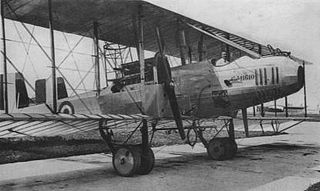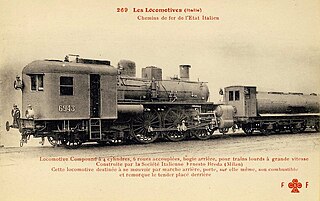
A diesel locomotive is a type of railway locomotive in which the prime mover is a diesel engine. Several types of diesel locomotives have been developed, differing mainly in the means by which mechanical power is conveyed to the driving wheels.

The Caproni Ca.5 was an Italian heavy bomber of the World War I and the postwar era. It was the final version of the series of aircraft that began with the Caproni Ca.1 in 1914.

The British Railways Class D3/7 were a class of 0-6-0 diesel electric shunting locomotives built as LMS Nos. 7080–7119. The class were built from May 1939 through to July 1942 by the London, Midland and Scottish Railway at their Derby Works using a diesel electric transmission supplied by English Electric.

The FS E.645 and E.646 are two classes of similar electric locomotives used on Italian railways. They were introduced during the 1950s and they were retired in 2009.

The FS E.636 is a class of Italian articulated electric locomotives. They were introduced in the course of the 1940s until the 1960s, and have been decommissioned since 2006. They have been one of the most numerous Italian locomotive group, and have been widely employed during their long career, hauling every type of train, ranging from freight to long range passenger services. Their introduction also saw the employment of some revolutionary design concepts, such as the articulated carbody and the three bogies scheme.

The ALn 772 series are a group of Diesel railcars built for the Italian public railway company Ferrovie dello Stato (FS) between the 1930s and the 1950s. As the first project in Italy to abandon the automobile-derived design and adopt a comprehensive "rolling stock" approach, it represents the link between the simple and sturdy Littorine and the modern Diesel units.

The FS E.444 is a class of Italian railways electric locomotives. They were introduced in the course of the 1960s until 1975. Starting from 1989, all E.444s were upgraded as E.444R.

The FS E.632 and E.633 are two classes of Italian railways electric locomotives. They were introduced in the course of the 1980s.

The EuroSprinter family of electric locomotives is a modular concept of locomotives for the European market built by Siemens Mobility. The internal Siemens product name is ES 64, with ES for EuroSprinter and the number 64 indicating the 6,400 kW power at rail.

The Piaggio P.119 was an Italian experimental fighter of World War II. It had a relatively novel layout, with a "buried" radial engine mounted mid-fuselage. Only a single prototype was built before the Armistice between Italy and the allied armed forces, which ended the project.

The HŽ series 1061 was a 6-axle articulated electric locomotive series that was used by Croatian Railways. In Slovenia it is known as SŽ series 362. This locomotive, built by Ansaldo-Breda, is derived from Italian FS Class E636 and was originally donated by the Italian government. It was known as JŽ series 362 in SFRJ. It was mostly used on the Rijeka - Zagreb railway and some auxiliary branches of this line. With the conversion of the Rijeka - Zagreb railway from 3KV DC electrical system to the 25 KV AC catenary, these locomotives were retired in 2012. Almost identical locomotives of this type on the Slovenian Railways were phased out in 2008.

The FS Class D.443 is a class of diesel-electric locomotive used in Italy, introduced in the late 1960s and still in service.

The FS Class D.345 is a class of diesel-electric locomotive used in Italy, introduced in the 1970s and still in service.

The RENFE Series 333 are high power six-axle diesel-electric locomotives built in the 1970s; at the time of their introduction they were the most powerful non-electric locomotives in Spain.

The Class D.445 is a class of diesel locomotives used by the Italian Ferrovie dello Stato (FS) railway company and by Trenord. 150 units were built between 1974 and 1988, divided into three series.

The Rete Adriatica Class 500, classified after 1905 in the Ferrovie dello Stato Italiane as Class 670 was an unorthodox and iconic cab forward 4-6-0 (2'C) steam locomotive.

The Ferrovie dello Stato Italiane Class 690 was a 4-6-2 'Pacific' steam locomotive for express trains.

The Ferrovie dello Stato Italiane Class 680 is a 2-6-2 express steam locomotive; it was the direct ancestor of the very successful and appreciated Class 685.
The Ferrovie dello Stato Italiane Class 310, formerly Rete Mediterranea Class 380, was a 0-6-0 steam locomotive; they were the first Italian as-built compound locomotives.

FS Class 400 were steam locomotives of French construction, built for service in Italy. They were 0-8-0 tender locomotives with two outside cylinders.



















